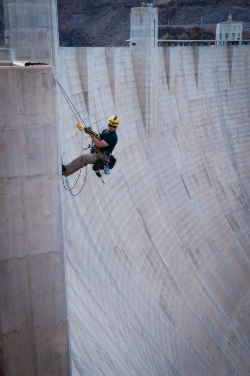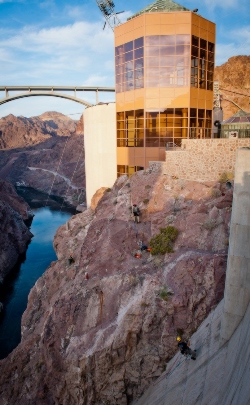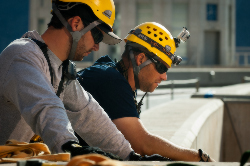Part 1: Rope Access Team applies
modern concepts to ancient craft, defying gravity
|
|||
| Photo Gallery | |
Rope Access Team applies modern concepts to ancient craft, defying gravity
Editor's note: The following article is part one of a two-part series, part 2.

The history of rope extends back thousands of years and may even be prehistoric, according to some historians.
Whether it was fabricated from reeds, vines, grass, leather or animal hair, or all of them combined, that rope has been important to humankind through the ages goes without question. One of the uses devised for this tool called for an individual to wrap a rope around the body to assist with ascending or descending an inclined or vertical surface where a slip or loss of a handhold could cause injury or death.
Today, ropes are manufactured to strict specifications, using modern materials and techniques, but their uses sometimes remain as basic as those implemented by early rope users.
One example of this ancient concept was demonstrated by the "highscalers" during the construction of Hoover Dam. This work meshed nicely with the definition of rope access according to the Society of Professional Rope Access Technicians (SPRAT), which states it is ". . . the use of ropes and specialized hardware as the primary means of access and support for workers. Rope access technicians descend, ascend and traverse ropes for access and work while suspended by harness or a work seat."

Moving rapidly from that decade to the present, a lucky visitor can witness a modern application from time-to-time of rope access.
Just last week a group of Lower Colorado Regional employees, who together comprise the Region's Rope Access Team, were applying their specialized skills at Hoover Dam to monitor the stability of the rock and stabilize loose rock before it actually falls.
"We inspect structures such as spillways, gates and penstocks, bridges, pumping plants, and intake towers," said Reclamation Rope Access Board Chairman Scott Foster, a group manager in the Engineering Services Office (ESO). "We then document concerns and report formal recommendations to mitigate risks."
"The primary responsibility of Reclamation's Rope Access Program is to inspect certain areas of our facilities that are normally inaccessible," he added. "Each Region, as well as the Denver Office, has a Rope Access Team.
"As we began inspections of the rock walls for an upcoming rockfall mitigation contract, we also removed undesirable vegetation and the ever accumulating trash," Foster said.
To beat the heat and crowds, Foster said they started ". . . real early," and, of course, they made sure they all stayed hydrated.

SPRAT states, "Rope access provides a safe method of working at height or in confined spaces where ropes and associated equipment are used to gain access to and from the workplace and to be supported there. The advantage of using such methods primarily lies in the safety and speed with which workers can get to or from difficult locations and then carry out their work, often with minimal impact on other operations."
"Another major benefit is that the total man-hours and level of risk for a task is often reduced when compared to other means of access," it continues.
In addition to Foster, who was the Lower Colorado Region Team Leader for the past four year, members of the LC Region Rope Team include Board Vice Chairman and Team Leader Rodney Tang of the Phoenix Area Office, and Corey Dickson, Nathaniel Gee, Jonathan Sanchez, and Brandon Barrow from the Regional Office.
Webmaster: sha-lcr-webcomments@usbr.gov
Updated:July 2, 2013

